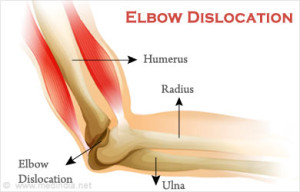Elbow Dislocation Causes, Symptoms, Diagnosis and Treatment

What is Elbow Dislocation?
An elbow dislocation occurs when the bones of the forearm (the radius and ulna) move out of place compared with the bone of the upper arm (the humerus).
The elbow joint, formed where these 3 bones meet, becomes dislocated, or out of joint.
Elbow dislocation is the second most common large joint dislocation in the adult population.
Toddlers may experience a dislocated elbow, sometimes known as nursemaid’s elbow, if they are lifted or swung by their forearms.
Causes of Elbow Dislocation:
Elbow dislocations are not common.
The injury takes the following course in adults:
- Elbow dislocations typically occur when a person falls onto an outstretched hand.
- When the hand hits the ground, the force is sent to the elbow.
- Usually, there is a turning motion in this force. This can drive and rotate the elbow out of its socket.
Elbow dislocations can also happen in car accidents when the passengers reach forward to cushion the impact. The force that is sent through the arm can dislocate the elbow, just as in a fall.
In toddlers, the injury often occurs when an extra pulling motion is applied to an outstretched arm. The causes of such injuries include:
- Improper lifting.
- Trying to lift or swing a young child by the arms can cause the elbow to dislocate.
- Sudden pulling.
- Having the child suddenly step off a curb or stair step as one is holding his or her hand can pull the elbow out of alignment.
The following factors increase the risk of incurring elbow dislocation:
- Younger children, having more flexible elbows, are at a higher risk of elbow dislocation.
- Some people are born with elbow ligaments that are looser than those of most people.
- Sports participation.
- Many elbow dislocations are sports-related. Sports that require weight bearing with the arms, such as gymnastics floor exercise, are especially risky for elbow dislocations.
Symptoms Of Elbow Dislocation:
The following signs and symptoms are exhibited:
- Extreme pain
- Obvious distortion of the joint
- Toddlers with nursemaid’s elbow might experience pain only when the affected elbow is moved.
- A child often avoids using the arm and holds it slightly flexed next to the body.
- Partial dislocation can cause bruising and pain where the ligaments were stretched or torn.
Diagnosis of Elbow Dislocation:
While diagnosing the elbow dislocation, the doctor will begin with an examination.
- The doctor will makes sure ones nerves and arteries are unhurt by checking the pulse, making sure one can feel normally, move ones fingers and wrist, and makes sure that blood is flowing normally to your hand.
- Next, the doctor will get X-rays. Sometimes, breaks in the bone can look like dislocations, and some breaks happen when dislocations occur.
- If the doctor suspects an injury to the artery, further tests, such as an arteriogram (an X-ray of your artery) may be performed.
Treatment of Elbow Dislocation:
The following treatment options are available:
- Medications
- Therapy
- Surgery
By : Natural Health News




